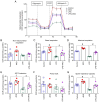α‑ketoglutarate protects against septic cardiomyopathy by improving mitochondrial mitophagy and fission
- PMID: 40183404
- PMCID: PMC11980534
- DOI: 10.3892/mmr.2025.13511
α‑ketoglutarate protects against septic cardiomyopathy by improving mitochondrial mitophagy and fission
Abstract
Septic cardiomyopathy is a considerable complication in sepsis, which has high mortality rates and an incompletely understood pathophysiology, which hinders the development of effective treatments. α‑ketoglutarate (AKG), a component of the tricarboxylic acid cycle, serves a role in cellular metabolic regulation. The present study delved into the therapeutic potential and underlying mechanisms of AKG in ameliorating septic cardiomyopathy. A mouse model of sepsis was generated and treated with AKG via the drinking water. Cardiac function was assessed using echocardiography, while the mitochondrial ultrastructure was examined using transmission electron microscopy. Additionally, in vitro, rat neonatal ventricular myocytes were treated with lipopolysaccharide (LPS) as a model of sepsis and then treated with AKG. Mitochondrial function was evaluated via ATP production and Seahorse assays. Additionally, the levels of reactive oxygen species were determined using dihydroethidium and chloromethyl derivative CM‑H2DCFDA staining, apoptosis was assessed using a TUNEL assay, and the expression levels of mitochondria‑associated proteins were analyzed by western blotting. Mice subjected to LPS treatment exhibited compromised cardiac function, reflected by elevated levels of atrial natriuretic peptide, B‑type natriuretic peptide and β‑myosin heavy chain. These mice also exhibited pronounced mitochondrial morphological disruptions and dysfunction in myocardial tissues; treatment with AKG ameliorated these changes. AKG restored cardiac function, reduced mitochondrial damage and corrected mitochondrial dysfunction. This was achieved primarily through increasing mitophagy and mitochondrial fission. In vitro, AKG reversed LPS‑induced cardiomyocyte apoptosis and dysregulation of mitochondrial energy metabolism by increasing mitophagy and fission. These results revealed that AKG administration mitigated cardiac dysfunction in septic cardiomyopathy by promoting the clearance of damaged mitochondria by increasing mitophagy and fission, underscoring its therapeutic potential in this context.
Keywords: AKG; fission; mitochondria; mitophagy; septic cardiomyopathy.
Conflict of interest statement
The authors declare that they have no competing interests.
Figures






Similar articles
-
Po-Ge-Jiu-Xin decoction alleviate sepsis-induced cardiomyopathy via regulating phosphatase and tensin homolog-induced putative kinase 1 /parkin-mediated mitophagy.J Ethnopharmacol. 2025 Jan 30;337(Pt 3):118952. doi: 10.1016/j.jep.2024.118952. Epub 2024 Oct 18. J Ethnopharmacol. 2025. PMID: 39426573
-
Dimethyl α-ketoglutarate ameliorates cisplatin-induced acute kidney injury by modulating mitophagy through the PINK1/Parkin pathway.Eur J Med Res. 2025 Aug 13;30(1):746. doi: 10.1186/s40001-025-03010-7. Eur J Med Res. 2025. PMID: 40796901 Free PMC article.
-
Salvianolic acid B improves mitochondrial dysfunction of septic cardiomyopathy via enhancing ATF5-mediated mitochondrial unfolded protein response.Toxicol Appl Pharmacol. 2024 Oct;491:117072. doi: 10.1016/j.taap.2024.117072. Epub 2024 Aug 15. Toxicol Appl Pharmacol. 2024. PMID: 39153513
-
The role of Drp1 in mitophagy and cell death in the heart.J Mol Cell Cardiol. 2020 May;142:138-145. doi: 10.1016/j.yjmcc.2020.04.015. Epub 2020 Apr 14. J Mol Cell Cardiol. 2020. PMID: 32302592 Free PMC article. Review.
-
Mitochondrial Mechanisms in Septic Cardiomyopathy.Int J Mol Sci. 2015 Aug 3;16(8):17763-78. doi: 10.3390/ijms160817763. Int J Mol Sci. 2015. PMID: 26247933 Free PMC article. Review.
References
-
- Fleischmann C, Scherag A, Adhikari NK, Hartog CS, Tsaganos T, Schlattmann P, Angus DC, Reinhart K, International Forum of Acute Care Trialists Assessment of global incidence and mortality of hospital-treated sepsis. Current estimates and limitations. Am J Respir Crit Care Med. 2016;193:259–272. doi: 10.1164/rccm.201504-0781OC. - DOI - PubMed
MeSH terms
Substances
LinkOut - more resources
Full Text Sources
Medical

